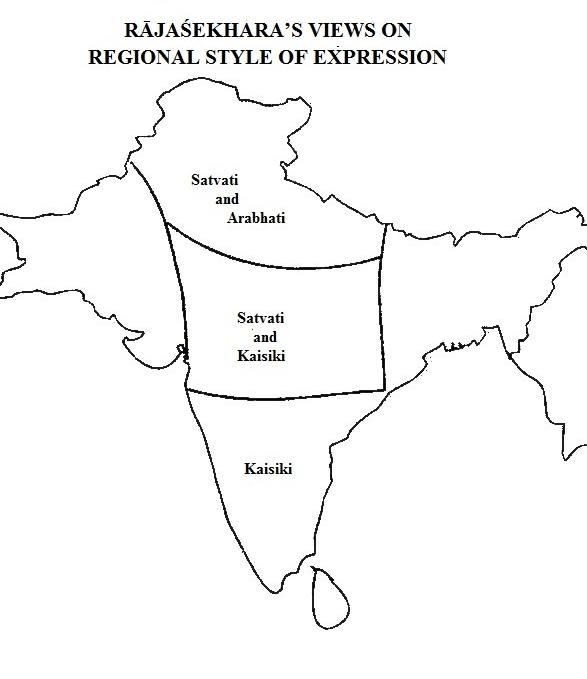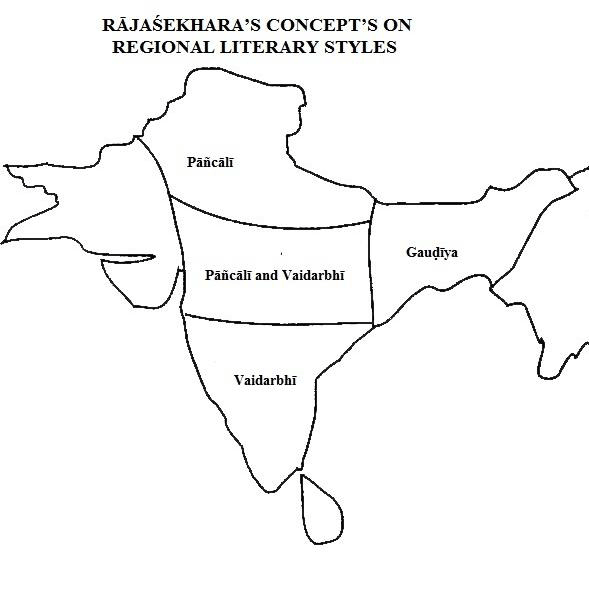Kavyamimamsa of Rajasekhara (Study)
by Debabrata Barai | 2014 | 105,667 words
This page relates ‘Synthesis of Riti, Vritti and Pravriitti’ of the English study on the Kavyamimamsa of Rajasekhara: a poetical encyclopedia from the 9th century dealing with the ancient Indian science of poetics and rhetoric (also know as alankara-shastra). The Kavya-mimamsa is written in eighteen chapters representing an educational framework for the poet (kavi) and instructs him in the science of applied poetics for the sake of making literature and poetry (kavya).
Part 3 - Synthesis of Rīti, Vṛtti and Pravṛitti
In the Sanskrit Poetics, the doctrine of Rasa and Dhvani, Alaṃkāras and Vakrokti, Guṇa and Rīti are complementary theory, maintain and patronage to each other. There are the junction theory of Rīti, Vṛtti and Pravṛtti are very close and cooperated that their importance cannot be explained without their proper elaborately discussion.
The sage Bharatamuni in his Nāṭyaśāstra described dress up, behavior, custom and vārtā of people based on the different part of the country. But there he has not say anything about the matter of synthesis about the Rīti, Vṛtti and Pravṛtti. He says:
“pṛthivyā nānādeśaveśabhāṣācārāḥ vārtāḥ khāpayatīti vṛttiḥ | pravṛttiśca nivedana |”
- Nāṭyaśāstra of Bharata: XIII
Bharatamuni divided country mainly on four parts and he has discussed the significance of four different types of pravṛttis based on different parts. In addition to this, he also posits Vṛtti’s as the mother of all the Kāvya (poetry) by the charming description of Vṛttis.
“sarveṣāmeva kāvyānāṃ māृtakāvṛttayaḥ smṛtāḥ |”
- Nāṭyaśāstra of Bharata: XX/ 4
In this way we can only found the analysis of vṛttis and pravṛttis on the dramatic angle, but there he doesn’t notice about the rīti. Then the follower rhetorician Bhāmaha, Vāmaṇa, Daṇḍin, Ānandavardhana and also Rudraṭa discusses the rīti based on the poetical points of view in their own works in different ways. But the Yāyāvarīya Rājaśekhara is the first Ālaṃkārika in the Sanskrit poetics that was established the synthesis of rīti, vṛtti and pravṛtti.
“tatra veśavinyāsakrama pravṛttiḥ, vilāsa vinyāsakramo vṛttiḥ, vacanavinnāsakramo rītiḥ|”
-Kāvyamīmāṃsā of Rājaśekhara: Ch-III, Pp- 9
That is also Rājaśekhara another mind-blowing contribution to the Sanskrit poetics from his original meditative.
However, Ācārya Bharatamuni, Bhāmaha, Bāṇabhatta and Daṇḍin divided rīti and pravṛtti according to the different regions of country and Rājaśekhara also agree with those types of classifications. Furthermore Rājaśekhara deeply highlighted the border of different regions especially based on the geographical perspectives.
According to Rājaśekhara, the country Aṅga, Vaṅga, Suha, Brahma, Kaliṅga, Kauśal, Tosal, Utkal, Magadha, Mudgar, Videha, Nepal, Tramraliptaka, Malada, Mallavartaka and Brahmattara etc. the eastern parts are the province of Gauḍīya rīti.
“atha sarve prathamaṃ prācīṃ diśaṃ śiśriyuryatrāṅgavaṅgasuhmavrahmapuṇḍrayadyā janapadāḥ | tathāvidhākalpayāpi tayā yadahavaṃśahavadīkṛtaḥ samāsavadanuprāsavadyogavṛttiparamparāgarbhaṃ jagāda sā gauḍīyā rītiḥ| ”
-Kāvyamīmāṃsā of Rājaśekhara: Ch-III, Pp- 8
Pāñcāla, Śūrasena, Hastināpura, Kaśmīra, Vālhīka and Bālhīka the northern parts are the place for Pāñcālī rīti.
“tataśca sa pāñcālānpatpuccācāla yatra pāñcālaśurasenapastināpurakāśmīravāhī-kavāhlīkavālyaveyādayo janapadāḥ| tathāvidhākalpayāpi tayā yadahavdaśaṃvadīkṛtaḥ īṣadasamāsaṃ īṣadanuprāsamupacāragarbhañca jagāda sā pāñcālī rītiḥ |”
-Kāvyamīmāṃsā of Rājaśekhara: Ch-III, Pp- 9
And, the Malaya, Kuntala, Kerala, Mahīsaka, Asmaka, Vidarbha, Kāñ chi, kaber, moral, chol, Dandak and Pandaya etc. Southern parts of the country are for the Vaidarbhī rīti.
“tataśca sa dakṣiṇāṃ diśamāsasāda yatra malayamekalaku ntalake ralapālamañjajaramapārāṣṭra vaṅgakaliṅgādayo janapadāḥ | yadatyarthaṃ ca sa tayā vaśaṃvadīkṛtaḥ sthānānuprāsavadasamāsaṃ yogṛvattigarbhaśca jagāda sā vaidarbhī rītiḥ |”
-Kāvyamīmāṃsā of Rājaśekhara: Ch-III, Pp- 9

Rājaśekhara described in the Kāvya (poetry) use of Auḍhra-Māgadhī Pravrtti, Bhāratī vṛtti and Gauḍiya rīti by the eastern region’s poet. Pāñ cāla-madhyamapravṛtti, Sāttavati vṛtti (grand style) or Ārabhatī vṛtti and Pāñ cālī rīti mostly uses the Pāñ cāla region’s kavi (poet). In this way the kavi (poet) of Daksina desa (southern part) of country also uses the dakṣinānta pravṛtti, vaidarbhī rīti and the kavi (poet) of Avantī deśa employed Avantī pravṛtti, Sāttavatī or Kauśikī vṛtti. There Rājaśekharas ascertainment about rīti is that, the uses of Samāsa (compounds) with anuprāśa (alliteration) or yoga vṛtti and the tradition of upacāra-yoga-vṛtti.
That is also Rājaśekhara another pure contribution to Sanskrit Poetics and gives him different fame in the history of Sanskrit poetics.

